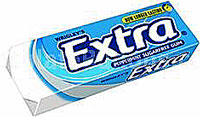 Ingredients
Ingredients- Sorbitol
- Mannitol
- Maltitol
- Aspartame
- Acesulfame K
- Gum base
- Carnauba wax
- Lecithin
- Gum arabic
- Glycerine (non-animal)
- Peppermint
- E171
- BHA
Published July 2009
Described as the official chewing gum of the Premier League, it also claims to be sugar-free - and it is.
Ingredients
Sorbitol (aka hexane-1,2,3,4,5,6-hexol) is a natural sweet-tasting alternative to sugar which does not cause tooth decay. Although it occurs naturally in some fruits, it is manufactured from glucose.
Mannitol has the same chemical formula as sorbitol but a slightly different molecular structure. It has similar sweetness but is medically more interesting. Mannitol can open channels into the brain and is used in conjunction with drugs that treat Alzheimer's disease. It is given intravenously to reduce fluid pressure on the brain following a severe blow, and it is given orally to remove overdoses of drugs by causing rapid diarrhoea.
Maltitol is made from starch and is almost as sweet as sugar but unlike sugar it does not cause tooth decay. It improves the texture of the gum.
Aspartame is an intense artificial sweetener as is acesulfame K. Used together they reinforce each other's sweetness so less of each is needed.
Gum base is the synthetic styrene-butadiene rubber (SBR) and isobutylene-isoprene polymer. It is this which gives the gum its chew. Originally chewing gum was based on atural chicle, made from the latex of the sapodilla tree of Central America.
Carnauba wax is there to lubricate the gum and it consists of long chain fatty acid esters and alcohols. Carnauba wax is used in polishes for cars, shoes, furniture, and glossy lipsticks.
Lecithin (E322) is the emulsifier and lubricant which not only softens the gum but helps all the components blend to an homogeneous mixture. Lecithin is extracted from animal and plant tissues but that in Extra gum come only from soybeans.
Glycerine (aka glycerol, propane-1,2,3-triol, or E422, is the humectant and is there to stop the gum drying out and becoming hard. Glycerine is a by-product in the production of soap from animal fats, and the making of biodiesel from plant oils. Only non-animal glycerol is used in Extra. Glycerine is used in cough medicines and suppositories, and it is added to liqueurs as a thickening agent.
Gum arabic (E414) is the sap of the acacia tree and is a mixture of carbohydrates and proteins. Traditionally it has been used for all sorts of things from glue for postage stamps to binders for watercolour paints. It is added to lots of foods as a thickening agent.
Peppermint relies for its flavour on menthol molecules which can trigger the cold-sensitive receptors on the tongue producing a feeling of freshness.
E171 is the pigment titanium dioxide (TiO2) which gives the gum coating its bright whiteness. Titanium dioxide has remarkable reflecting power so it is added to paints and sun-block creams. It is also used to make paper, toothpaste, and the icing of wedding cakes look brilliantly white.
BHA (aka E320) is short for butylated hydroxyanisole. It protects the gum base from attack by atmospheric oxygen and is added to all kinds of foods and products containing fats and oils such as crisps, cosmetics, and pharmaceuticals. Some groups oppose BHA on health grounds, linking it to cancer, but with no scientific evidence to back this up.